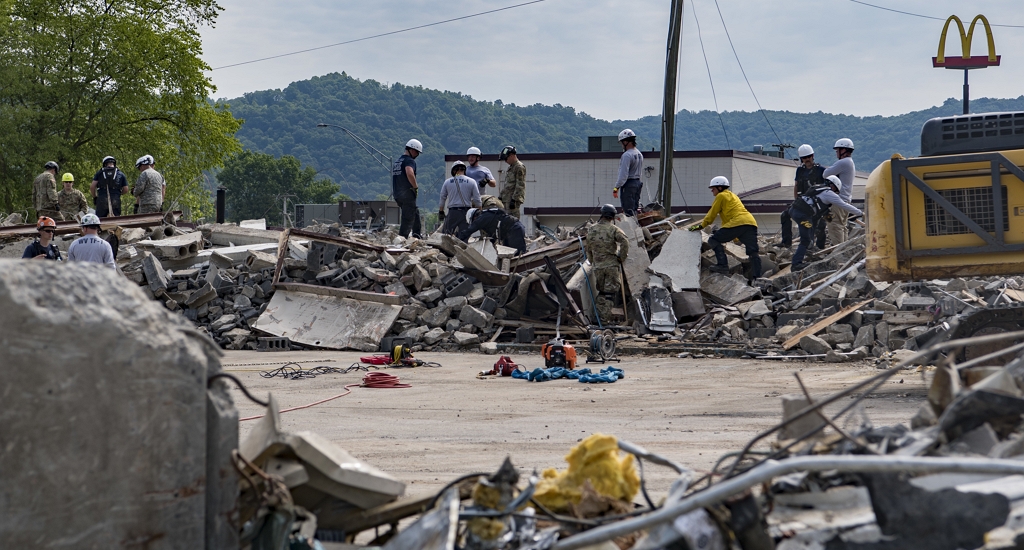Description
An earthquake is the motion or trembling of the ground produced by sudden displacement of rock in the Earth’s crust. Earthquakes result from crustal strain, volcanism, landslides, or the collapse of caverns and mines. Located near the center of the North American Tectonic plate, earthquakes in Virginia are known as "intraplate seismicity", and typically occur on faults at depths between 3 and 15 miles.
Location and Extent
In 2014, the USGS updated national seismic hazard maps which include the latest science-based information on potential future earthquake ground motions. The hazard models incorporate more than 100 years of global earthquake observations at several hundred thousand sites across the United States. Probabilistic ground motion maps are typically used to assess the magnitude and frequency of seismic events. These maps measure the probability of exceeding a certain ground motion, expressed as percent peak ground acceleration (%PGA), over a specified period of years. The USGS long-term national earthquake hazard map depicts peak ground accelerations having a 2 percent probability of being exceeded in 50 years, for a firm rock site. According to the map, all the jurisdictions in the CVPDC area are located in low probability areas therefore the future threat is low.
The severity of earthquakes is site specific, and is influenced by proximity to the earthquake epicenter and soil type, among other factors. The 100-year return period or one percent probability of happening in any given year, for a significant earthquake is very low, with southwest Virginia having a slightly higher chance of experiencing such an event.
During an earthquake when the ground is shaking, it experiences acceleration. The peak ground acceleration (PGA) is the largest increase in velocity recorded by a particular station during an earthquake.(https://earthquake.usgs.gov/hazards/learn/technical.php#accel)
History
In Virginia, a written record of earthquakes exists back to the 18th century. Most of Virginia’s recorded earthquakes have been magnitude 4.5 or less, and the associated damage has been minor (cracks in foundation, tumbling chimneys, etc.). The largest magnitude earthquake in Virginia, a 5.8 magnitude (MMI VI) on the Richter scale, occurred on August 23, 2011. The epicenter of the earthquake was located in Louisa County, Virginia, approximately 80 miles northeast of Lynchburg. It was likely felt by more people than any other earthquake in U.S. history: approximately 1/3 of the U.S. population. According to VDEM, this earthquake caused between $200 and $300 million in damages of which only about $100 million were insured. Those damages included the North Anna Nuclear Generating Station, a gas leak in Charlottesville, the Lake Jackson Dam and the Washington Monument. In response to this event, FEMA issued a major disaster declaration (DR-4042) to offer assistance to the residents and businesses that suffered damages in central Virginia.
Significant earthquakes in Virginia (magnitude greater than 4.5)
|
Date |
Local Time |
Magnitude |
Magnitude Type |
Intensity |
Localities |
|---|---|---|---|---|---|
|
02/02/1774 (a) |
2:00pm |
4.5 |
Mb |
VI |
Petersburg |
|
03/09/1828 |
10:00pm |
5 |
Mb |
V |
Southwest VA |
|
08/27/1833 |
6:15am |
5 |
Mb_lg |
VI |
Richmond-Charlottesville |
|
04/29/1852 |
12:45pm |
4.9 |
Mb |
VI |
Grayson-Wythe |
|
05/2/1853 |
9:20am |
4.6 |
Mb |
VI |
VA/WVA border |
|
12/22/1875 |
11:45pm |
4.5 |
Mb_lg |
VII |
Richmond |
|
05/31/1897 (b) |
1:58pm |
5.5 |
Mw |
VIII |
Pearisburg |
|
11/25/1898 |
3:10pm |
4.6 |
Mb |
V |
Pulaski-Wytheville |
|
02/13/1899 |
4:30am |
4.7 |
Mb |
V |
Wytheville |
|
4/9/1918 |
9:09pm |
4.6 |
ML |
VI |
Luray |
|
12/9/2003 (c) |
3:59pm |
4.5 |
Mb_lg |
VI |
Columbia |
|
8/23/2011 (d) |
12:51pm |
5.8 |
Mw |
VIII |
Mineral |
|
8/25/2011 |
12:07am |
4.5 |
Mb_lg |
VI |
Mineral |
a) The first documented earthquake in Virginia. (b) The second largest earthquake in Virginia. (c) The largest earthquake recorded in Virginia since the widespread use of modern seismic equipment in the 1970's. (d) The largest Virginia earthquake recorded by seismometers.
Earthquakes occur underground along geologic faults. Although Virginia has many faults, nearly all of them are inactive. Most earthquakes in Virginia are not associated with a known fault, but concentrated in three distinct seismic zones: the Central Virginia seismic zone (CSVZ), the Giles County seismic zone (GCSZ), and the Eastern Tennessee seismic zone (ETSZ). The CVPDC area is situated on the periphery or within the CVSZ. Although there are documented damages from earthquakes in the CVPDC, and estimated epicenters from the 1800s located in Lynchburg, there has never been a well recorded earthquake that has occurred in the CVPDC area.
Plan Chapter
CVPDC HMP 2020





